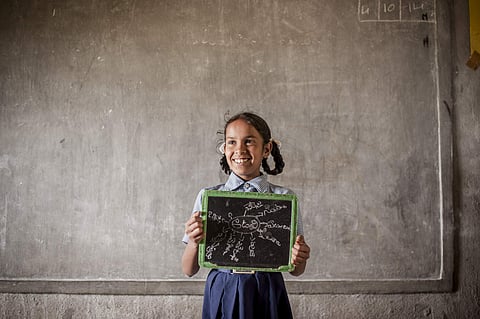

Raashi hid from her parents the fact that her own school headmaster was harassing her. Already, getting to school meant a commute of two hours. If her mother were to find out about all this...she shuddered to think what would transpire.
She was right. When her family found out, they banned her from going back to school, worried about the effect on their ‘honour’ if she was sexually assaulted. The plan now is to get her married. She is 15. And she is not alone. Nearly 40% of Tamil Nadu girls who marry young are in the 11-15 age group, according to an Explorative Study on Forced Early Girl Child Marriage.
Gowri Devi from Bihar is luckier. Her mother is stubborn that no matter what, her 13-year-old will go to school. Her mother hopes Gowri will become a doctor. But there are 70 pupils in a class at her school, and the teachers often just don’t show up. There’s one broken toilet for both sexes to use. Somehow, her mother saves 1000 rupees a month to pay for private tuition in three subjects.
Savithri in Telangana is battling for her child’s future, too. Her 8-year-old son Ranga has learning disabilities and she has tried to get him into school every year. Finally, the authorities have agreed he should get some education, but it’s only for one day a week. A domestic help who never went to school herself, she wonders if she should have tried to teach him at home.
The World Bank upgraded India from a ‘poor’ country to a middle-income one a few years ago. As a consequence, the UK announced that it would end aid to India from 2015, as the country had a space programme, over 50 billionaires and its own aid budget.
Though the Right to Education (RTE) Act guarantees a free and compulsory education for all children, the ground reality is in stark contrast to the amount of money the government splashes on publicity in the name of education for the girl child.
Take Beti Bachao Beti Padhao for instance. Launched in 2015, the scheme aims to address the declining Child Sex Ratio and related issues of women empowerment. It is a triministerial effort of the Ministries of Women and Child Development, Health & Family Welfare and Human Resource Development. But the budgetary allocation for taking education to the grassroots in 2018-2019 is `70.63 crore, as opposed to the publicity budget for the scheme in the same year which stands at `155.71 crore. When you do the math, the allocation per child is 5 paisa and alarmingly, 56% of the scheme’s budgetary allocation has been spent on publicity. And till date there hasn’t been any assessment of this scheme! How can we measure if education is reaching children if there is no transparent metric to ensure the programme budget is being spent on education?
The Global Campaign for Education (GCE) wants all nations to allocate at least 6% of the GDP to education. However, it is an issue of political will, rather than a lack of cash. Girl child education is not a vote-winning issue in a system of frequent elections, where pledges need to be deliverable immediately.
What is disheartening is that there has been a steady decline in budgetary allocation for education in the last 4.5 years — according to a comprehensive report by CRY (Child Rights and You). Whilst children are constantly used in political speeches to ask parents to vote for their children’s future, children were invisible in the government’s 10-point vision for 2030.
In the last five years, the education sector has seen many straight and indirect problems from the government — ranging from a lesser number of seats in higher education, a failing reservation system and insignificant allocations to the public-funded education system. The teachers, especially the contractual teachers working in government schools under various schemes, have been one of the worst affected sections in the recent past.
While our aim is to produce young minds that are ready to take on all the challenges of a competitive world, we must not forget to engineer their inner being too. However, if our country continues with this skewed focus on education, the rich demographic dividend can become a demographic catastrophe — especially in an emotionally charged country like ours, because the unfulfilled and under-educated youth fall prey to the cartels of terrorism and drugs.
My strong appeal is that we not only focus on publicising key education schemes, but also to truly focus on how we are raising our children to learn to live, flourish and give back to society. This can happen only when we focus on quality education at all levels.
(Views expressed here are the author’s own. All names have been changed to protect privacy)
Apsara Reddy is a noted gender activist, journalist and the National General Secretary and Communication In-Charge, All India Mahila Congress. She has written extensively on education and campaigned for equitable gender-based education
